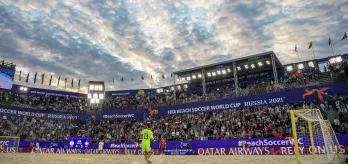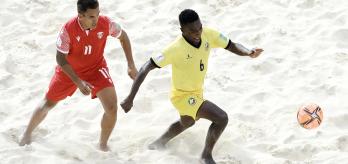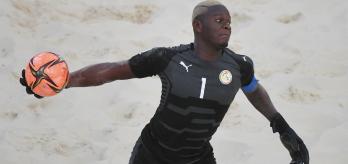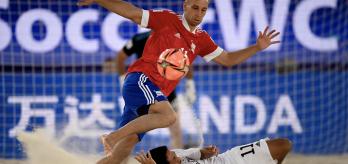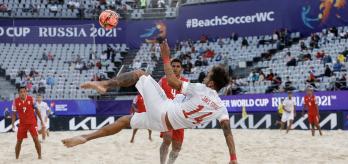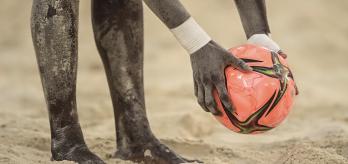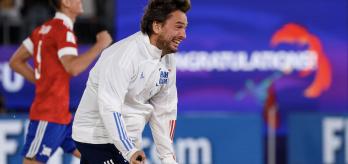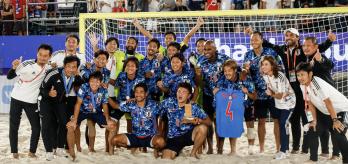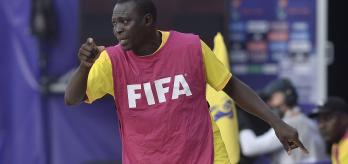Individual Attacks
The collective development of the attacking phase, when the opposing team is organised behind the ball, can be characterised not only by combination attacks or direct attacks, but also by individual attacks.
The FIFA Technical Study Group (TSG) has divided individual attacks into two categories:
- individual attacks by goalkeepers: especially in the attacking 2-2 system, when the goalkeeper is not pressed by the opponents (who prefer to mark outfield players individually and take advantage of the pressure exerted by the new four-second rule on goalkeepers in possession of the ball in their half of the pitch), they frequently drive towards the opponents’ goal; and
- individual attacks by outfield players: these are situations in which outfield players decide to make use exclusively of their own individual technical skills and tactics, without their team-mates' support in the passage of play in an attempt to create a scoring opportunity.
Goalkeeper
With regard to individual attacks by goalkeepers, at the FIFA Beach Soccer World Cup Russia 2021™, goals scored directly by goalkeepers accounted for only six out of 175 scored from open play. This shows the increasing difficulty for goalkeepers to develop efficiency when shooting from long distance, due to the pressure exerted by the four-second limit when in possession in their own half of the pitch.
Outfield player - dribbling
The number of individual attacks by outfield players that were converted directly into goals was 19, or 10.9% of the total goals scored from open play. These 19 goals can in turn be assigned to different types.
The ones of most interest are those scored after navigating tackles by one or more direct opponents. There are fundamental attacking technical skills of a certain type, including the ability to dribble, the ability to control the ball in the sand (which in this case, because of the unevenness of the surface, almost always helps the defending player) and handle it at speed, the individual player's ability to determine whether they are in the best situation to attempt an individual attacking move (taking into account the area of the pitch they are in and where their team-mates and opponents are).
At present in beach soccer, which has seen remarkable growth in defensive discipline at both an individual and team level, it has become very important to invest in the preparation and development of individual attacking skills such as dribbling, which allows the immediate creation of an overload even in initial situations of equal numbers. These are now much more common than in the past (due to the introduction of the new four-second rule, as already explained in previous articles).
Outfield player - shots from distance and stray balls
This discussion of individual attacks obviously also includes goals scored from long-distance shots, and particularly all loose-ball situations, i.e. where there is no clear possession by either team (for example, goals scored after a save by the goalkeeper, among others). The speed and opportunism of the players most able to react become decisive here.
Counter-attacks
It is now time to analyse an attacking ploy that, unlike combination attacks, whether direct or individual, takes place when the team not in possession is defensively disorganised: the counter-attack.
Counter-attacks take place when a team wins possession and launches a swift attack, seeking to immediately exploit the space left by the opponents, who do not have time to reorganise themselves defensively behind the ball.
The TSG has divided counter-attacks into two types: individual, where a single player attacks the opponents' goal immediately after winning possession, and collective, where multiple players from the same team participate in the move.
At the FIFA Beach Soccer World Cup Russia 2021™, of the 175 goals scored from open play, 55 were as a result of counter-attacks (31.4%), of which 47 were collective (including three restart counter-attacks) and seven individual. These numbers are higher than those for goals scored as a result of combination attacks (41), direct attacks (53) or individual goals (19). These are important figures, which show that beach soccer is currently greatly influenced by teams' ability to react swiftly in the moments of transition in the game, from defensive to attacking and vice versa.
All the teams that made it through the group stage (except Uruguay) at the FIFA Beach Soccer World Cup Russia 2021 had quite high percentages of goals scored from counter-attacks relative to their total goals scored from open play. However, the team with the highest proportion of goals from counter-attacks was Mozambique, which often took the opposition by surprise by exploiting the speed of their players from restarts.
When reacting to winning the ball, the most important requirements for players are vision, an understanding of which spaces to attack, doing so at speed, and the ability to manage the overload that develops.
In the defensive phase, it is crucial for the defence to have been organised first during the possession phase. In addition, when the ball is lost and a counter-attack is put together, the ability to defend while outnumbered comes into play in a bid, where possible, to slow down the attack in order to allow team-mates to get back into position.
Finally, the already mentioned frequency of these two stages of transition requires, above all, the highest level of physical fitness and athleticism, which is an increasingly indispensable requirement in modern beach soccer.
At the FIFA Beach Soccer World Cup Russia 2021, counter-attacks originated from different situations:
1) Winning the ball by a defender in a 1v1 duel, creating an overload and/or exploiting a lack of prior defensive organisation
2) Winning the ball by the defending team, creating an overload and/or exploiting a lack of prior defensive organisation, with use of the goalkeeper
3) Winning the ball as a result of defensive anticipation (interception) or after a blocked shot
4) Winning the ball after an error in the development phase by the team in possession or in the case of a stray ball
5) Winning the ball in the defensive phase of a corner, an attacking throw-in or a kick-off










